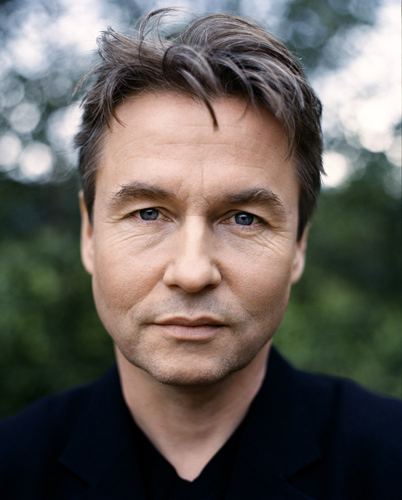A mixed night of Mahler from Salonen, MET Orchestra

Esa-Pekka Salonen conducted the MET Orchestra Wednesday night at Carnegie Hall. Photo: Nicho Soedling
Gustav Mahler never composed an opera, but he was a legendary opera conductor, and it’s not hard to imagine opera musicians wanting to try their hands at his characterful songs and his intensely dramatic symphonies.
The MET Orchestra and two Met stalwarts, mezzo-soprano Susan Graham and tenor Matthew Polenzani, yielded to the Mahler urge at Carnegie Hall Wednesday night. Esa-Pekka Salonen led the orchestra in performances of songs from Des Knaben Wunderhorn and the Symphony No. 1 that ranged from diverting to disappointing.
The Wunderhorn songs fared the better of the two works, as both singers fulfilled their basic obligation to be heard over the large orchestra (after a too-soft opening by Polenzani in the first song) and Salonen contributed well-mixed orchestral colors.
Despite the large forces, Mahler approached his folk-poetry texts with a lieder sensibility, the drama more internal than overt (even in “Das irdische Leben,” which recounts the death of a child), and irony the prevailing attitude. In the main, the opera stars adapted to this atmosphere well, with Graham in particular mining comic gold from songs such as “Verlor’ne Müh” and the closing “Lob des hohen Verstandes.”
Graham’s dramatic flair helped cover, if not a multitude, at least a handful of sins, as when, in the last song, the singer went noticeably out of synch with the orchestra in a couple of places, prompting sheepish smiles and shrugs from Graham during the bows.
Still, there were moments she could have pointed to with pride, such as the weightless, floating phrases of “Rheinlegendchen,” and the fine line she walked in “Das irdisches Leben” between Erlkönig-like realism and the emotional distancing of a folk tale.
Of the ten songs performed Wednesday—i.e., all of Mahler’s Wunderhorn settings that didn’t become movements in his symphonies—six are in dialogue form, where two different characters speak to each other. Wisely, the opera singers steered a conservative course when it came to impersonating the characters in the song, leaving it largely to Mahler’s clever accompaniments to indicate who was speaking.
Once he found his vocal footing, Polenzani sang with energy, agility and clear diction, and managed a bit of nasal sneer when needed, as in “Des Antonius von Padua Fischpredigt,” Mahler’s swimmy, wry account of the saint’s sermon to the fish.
More of that attitude would have been welcome Wednesday night. Irony is a hard thing to convey in music, but it lurks in nearly every corner of these songs, and not much of it came through the well-shaped vocalizing and the charmingly Viennese chocolate-soldier accompaniments.
However, Salonen and his players produced some admirable effects along the way, such as fluid clarinet-and-strings work in the “Fischpredigt,” and a delicate tissue of nature sounds and droll noises in “Lob des hohen Verstandes.” If there is such a thing as a sensitive bugle call, principal trumpet David Krauss produced one in “Wo die schönen Trompeten blasen.”
There was enough right about this Wunderhorn performance to raise hopes for at least a colorful performance of the Symphony No. 1. Those hopes were not realized, as the vaunted opera orchestra, on this night at least, played like a pit band with delusions of grandeur. Its monotonous, out-of-focus performance could be easily surpassed, for clarity and spirit, by any number of student orchestras around the country.
In the first movement, Mahler’s glinting highlights and sudden shadows seemed to blend into one all-purpose orchestral sonority that got louder and softer, and faster and slower, but not much else, like an organ stuck in one registration. Winds struggled to enter together, and strings to stay together. Not even the shift to minor in the development brought a color change in the sound.
Salonen conducted the Ländler scherzo and its waltz trio with arm punches and head jerks, with the result one would expect, a wooden performance with hardly any dance lift. The dark irony of the “huntsman’s funeral” third movement would have benefited from clearer lines in the moaning bassoon and the chirping oboe, and the same went for the sentimentality and sarcasm of the klezmer-style interlude.
The orchestral malaise was hard to diagnose from Row V, but the orchestra gave the impression of being ill at ease with Salonen’s laconic, let-the-players-do-it conducting style.
Neither the terrible crash that launches the finale nor the tender violin theme that followed carried much emotional weight, but just sounded loud and soft respectively. The triumphant major-key coda sounded very loud, but the orchestra also mustered a good deal of collective energy, which brought on vigorous applause at the end. Other than that big finish, it’s hard to imagine what else about this performance would prompt such a response.
The MET Orchestra will perform works of Schumann and Mahler 3 p.m. Saturday and works of Mahler and Sibelius 8 p.m. Tuesday at Carnegie Hall. carnegiehall.org; 212-247-7800.






